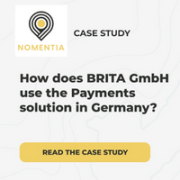Cash Flow Forecasting – Why having the right tools can prove a significant advantage
| 10-11-2021 | treasuryXL | Nomentia | LinkedIn
Introduction David Kelin
David Kelin is the Managing Director of DNA Treasury Limited. He is a cash management specialist with over 30 years of experience working with corporates and financial institutions. Expertise in helping companies analyse their cash management requirements. He has experience in providing advice on treasury management systems selection. Recently he attended a roundtable discussion on cash flow forecasting for Nomentia, and tells us why cash flow forecasting is a crucial activity for every treasury department.
Round table on cashflow forecasting
I recently chaired a roundtable discussion on cashflow forecasting for Nomentia, a market-leading cash management & treasury solutions provider headquartered in Finland. The group included a cross section of treasury professionals representing a wide range of industry sectors and companies of varying sizes but each shared one common objective: how to best improve their cashflow forecasting processes and methods.
Of the many interesting themes to emerge, one challenge remained agnostic to each treasurer: securing ongoing collaboration from their business units and subsidiaries in the provision of reliable, consistent and accurate cashflow data. Given the importance of accurate cashflow forecasting for organisations of all sizes in today’s economic climate, this is one area of the cash forecasting process we’ll return to at a later stage in this article.
According to the Office of National Statistics (ONS) in the UK, 90% of businesses fail due to cash flow issues. Sir Richard Branson summed it up very well when he said, “Never take your eyes of the cash flow because it’s the life blood of the business.”

Focus on cash flow
Cash flow management is crucial for business survival and well-informed decision making around cash flow maximisation can ensure companies are adequately equipped to navigate times of uncertainty and plan for the long-term. Focussing on cash flow, rather than profit, is what successful businesses do. Let’s think of this in simple terms: a profit-making business that does not manage its cash flows effectively can struggle to pay suppliers and suffer from subsequent delays in meeting customer demand. The end result is unhappy suppliers, lost customers and a negative impact on profits.
The burning question therefore remains, if we unanimously agree that cash flow management is vital to business success, then why does it continue to prove an ongoing headache for many organisations. A sentiment I regularly encounter when meeting with treasurers across my network and hotly resonated during the course of the roundtable in question.
Data is key
When we explored this matter in more detail there was a broad consensus that cash flow forecasting is only as good as the data it comprises. The old adage of Garbage In, Garbage Out (GIGO) is true for cash flow forecasting. Inaccurate data leads to inaccurate forecasting, rendering the process inadequate and almost unfit for purpose.
The key outcome? Data is absolutely key. But data can come from many different sources for example the P&L, ERP systems, payroll etc. These data sources tend to be reliable in so much as they reflect known activities, however as a panel member correctly pointed out, relying on data that is derived from the P&L alone, to produce the forecast, does not lead to accuracy. You must also get the business units to provide and update cash flow forecast data in order to complete the picture.
Securing business unit ‘buy-in’ to the benefits of the forecasting process and, just as importantly, being able to depend on their full collaboration around accurate data provision can sometimes prove a hard challenge – here’s some guidelines to increase your likelihood of success:
- Get senior management buy-in: the panel agreed it’s not enough for Treasury to simply tell the businesses to provide accurate, timely and reliable data. The process should be endorsed and championed by senior management through regular communication to the business units
- Communication, Communication, Communication!: business units must also buy-in to the process. Companies that are the most successful at cashflow forecasting agree that when business units understand the importance of good forecasting, they tend to do a better job of providing quality data. A good example of this was offered by one of our panel members –
“We meet with our business units on a regular basis to explain why we ask them for cash flow forecast information. We always say that poor cash forecasting affects our bottom line. If you get your forecasting wrong, then your exposures are wrong, your hedging is wrong and this can ultimately lead to a potential FX loss which in turn, affects the P&L.”
Another treasurer further explained:
“The best business units are those who have bought into the forecasting process and understand its importance to the whole organisation. They take pride in providing accurate data in a timely manner. This behaviour doesn’t happen overnight but as a result of a change in the company culture which they have bought into. Cash flow forecasting is now part of our Key Performance Indicators (KPI’s).”
- The right tools for the job: getting buy-in from business units takes more than just great communication. Panel members were clear that you need to make the data provision process as easy as possible, given most business units are busy running day-to-day operations and have limited bandwidth.
Providing the right tools for the job demonstrates treasury’s commitment to supporting business units with their part of the process. Spreadsheets can be a quick, no-cost tool of choice but are prone to human error and require consolidation at treasury level. Spreadsheets are also time-consuming, not user-friendly and limit data manipulation capabilities around forecast comparisons, variance analysis, what-if scenarios etc. Modern and affordable specialist cloud cash forecasting systems are fast replacing spreadsheets as the forecasting tool of choice, allowing business units input or update data from anywhere, quickly, efficiently and accurately.
In summary, cash flow forecasting is a crucial activity for treasury departments everywhere but to do it well you need to ensure that the entities supplying the information have bought into the process and are provided with the best tools for doing it.











